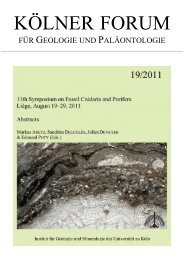Download (6Mb) - USP Electronic Research Repository - The ...
Download (6Mb) - USP Electronic Research Repository - The ...
Download (6Mb) - USP Electronic Research Repository - The ...
Create successful ePaper yourself
Turn your PDF publications into a flip-book with our unique Google optimized e-Paper software.
Rotuman Distribution<br />
Hapmafau (*HAP281 <strong>USP</strong> S5: 12).<br />
Habitat and Remarks<br />
Epiphytic on Valonia aegagropila and Dictyota friabilis in sheltered back reef locations.<br />
Phytobiogeographical Analysis of the Rotuman Algal Flora<br />
Comparison of Sites on the Island<br />
<strong>The</strong>se data are graphically presented in figs 209-210. <strong>The</strong> total flora to date consists of 88<br />
taxa. <strong>The</strong> Rhodophyta comprise the majority of the flora (46.6%; 41 taxa), with the<br />
Phaeophyta being least represented (12.5%; 11 taxa). Chlorophyta consist of 40.9% of the<br />
flora, or 36 taxa. Owing to the uncertain taxonomy of the majority of the Cyanophyceae,<br />
they are excluded from the analysis, although they are widespread at most stations.<br />
Comparison of stations reveals marked differences in the occurence of red algae, although<br />
the green algae have a more constant distribution. <strong>The</strong>re is also a marked north-south<br />
distribution pattern of certain species of Chlorophyta, especially Halimeda and Caulerpa<br />
(Fig. 21 1). <strong>The</strong> latter trend may reflect differences in the habitats of opposite coasts on the<br />
island, as discussed below.<br />
Discussion<br />
North-South Distribution Patterns<br />
As can be seen from Fig. 21 1, there is marked difference in north-south distribution of<br />
Rotuman algae, especially with respect to the genera Halimeda, Avrainvillea, Rhipilia,<br />
Melanamansia and Caulerpa. This could be attributed in part to the different habitats on<br />
opposite sides of the island, which are predominantly sandy and sheltered to the north<br />
(favouring Halimeda and Melanamansia growth) and relatively rocky and exposed to the<br />
south (favouring more cryptic, robust species).<br />
<strong>The</strong> Caulerpa distribution is, however, the opposite, with sites on the north coast (e.g.<br />
Lopta) being rich in clumps of relatively resistant Caulerpa racemosa var, uvifera, whereas<br />
the sandy and protected area of Hapmafau Bay at the Motusa Isthmus favours growth of<br />
larger and less robust Caulerpa species (Caulerpa racemosa var. peltata, Caulerpa<br />
cupressoides, Caulerpa serrulata). It should be stressed that Hapmafau Bay is not a typical<br />
southern station, most of which support robust forms of Caulerpa serrulata (e.g. at Tuakoi,<br />
Savlei).<br />
A possible explanation for these distribution patterns could be the orientation of the<br />
island, which lies approximately in an east-west line. <strong>The</strong> southern coast is therefore more<br />
exposed to the south-east trade winds predominant most of the year in this part of the Pacific,<br />
resulting in significantly more wave-washed and eroded habitats. <strong>The</strong> northern coast, on the<br />
other hand, is-relatively protected and this has allowed the accumulation of sandy deposits<br />
and the formation of small lagoons and tidal pools, favouring growth of such species as<br />
Halimeda, Avrainvillea, Rhipilia and Melanamansia.<br />
Rotuma in the Context of Other South Pacific Islands<br />
Probably the most distinctive feature about Rotuma is its isolation, as it is not<br />
geographically connected to any other island or island group. In this aspect, it resembles<br />
Lord Howe Island or Easter Island, both high volcanic islands. In size, it is much smaller<br />
than its nearest neighbouring islands in Fiji, and its combination of equatorial climate and<br />
extremely fertile volcanic soil makes it a far more productive island than most of the<br />
predominantly coral atolls to the north such as Tuvalu and Kiribati.<br />
<strong>The</strong> small size of the island, coupled with its mostly exposed fringing reef structure,<br />
severely limits the types of algal habitats found there. <strong>The</strong>re are thus marked floristic<br />
differences to be expected when comparing the island with such locations as the Solomons,<br />
Samoa, New Caledonia or Fiji, all of which have wide ranges of algal habitats. In particular,

















